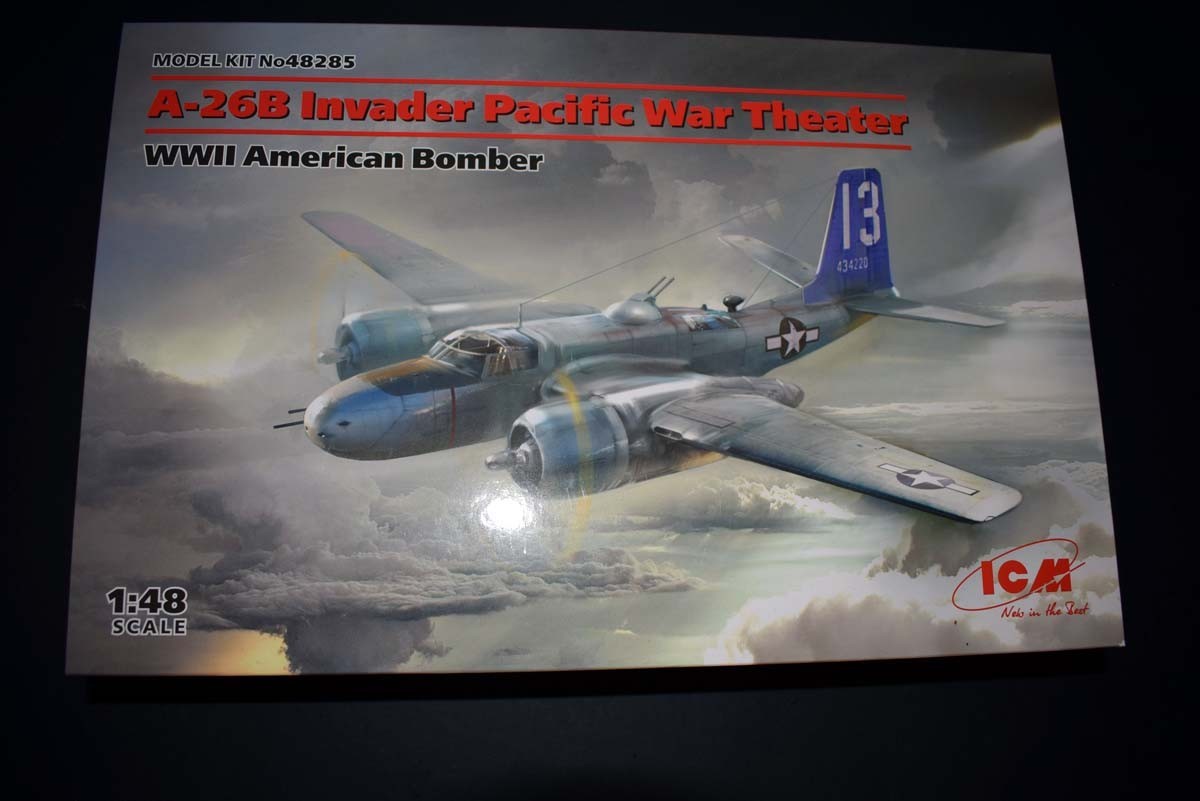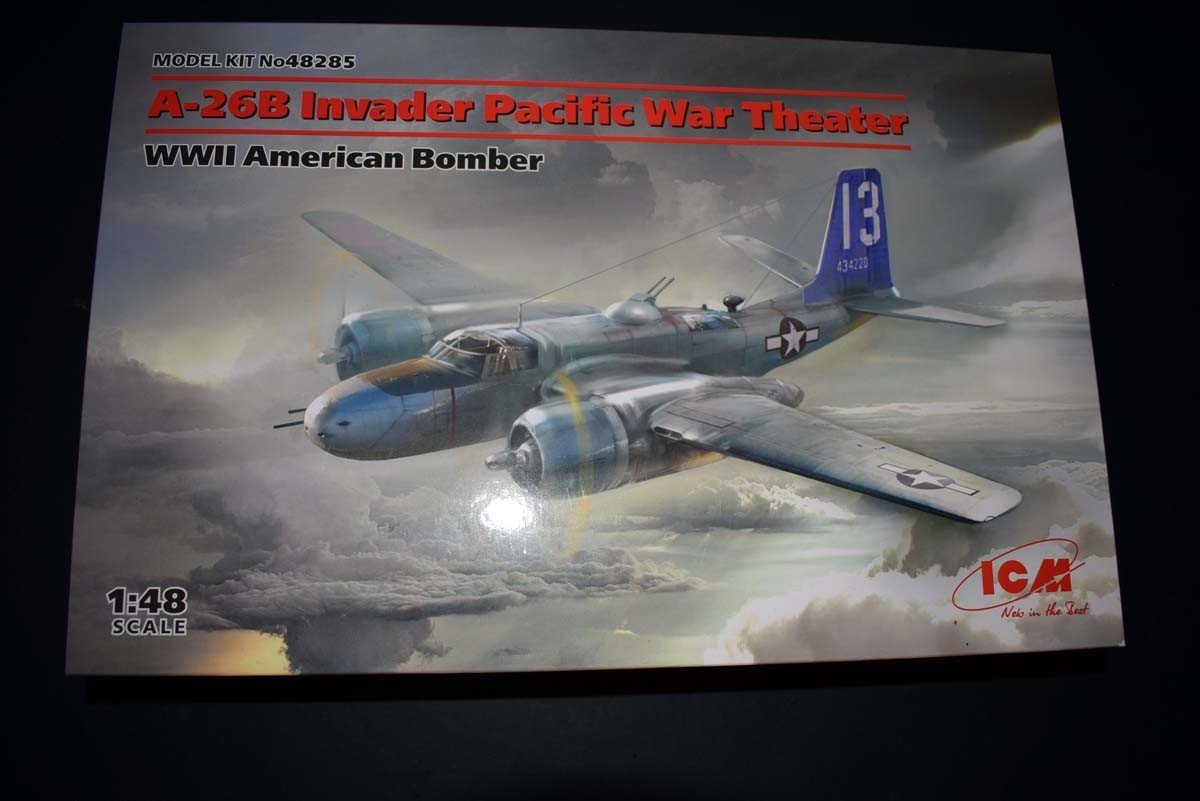Introduction
B-26 Invader was a remarkable aircraft seeing service with the United States Air Force at the end of the Second World War, through the Korean War and even saw service during the Vietnam War; this aircraft also served with the French during the Indo-Chino War before the Americans got involved and later Algeria. The B-26 was tested and trialled early during World War 2, but due to requirements placed upon Douglas Aircraft from contracts already in existence a production aircraft was not completed until 1944; a real shame when you consider just how effective this aircraft turned out to be. There was no A variant of the B-26 built as a production aircraft due to I believe the time between the trials aircraft and a production aircraft being completed, but there were a lot of different set ups tested, even a night fighter version was produced but lost out to the P-61 due to the production of the P-61 already being in production. When this aircraft finally went into production it resulted in an aircraft that was forgiving in flight, sturdy, well armed in various configurations and effective at both low and medium height. Let’s take a look at the latest 1/48th scale model offering from ICM of a World War 2 A-26B Invader serving in the Pacific War Theatre. This offering from ICM is the late WW2 B-26 Invader due to the armament set up such as wing mounted guns.

Review
This offering of the A-26 is packaged in the usual way favoured by ICM and approved of by me; a cardboard tray with flip top lid that provides a high degree of protection and a separate card lid with all of the artwork on it. Inside you will find an instruction booklet with the decal sheet inside. The model parts are in a single re-sealable bag that also contains the clear mouldings in their own bag. An initial inspection does not cause me any concerns beyond some flowlines in the larger mouldings, but these pass the look and feel test.
Interior
The internals of this model are surprisingly wide reaching and well produced by ICM. The internal frame structure is replicated from the nose nearly all the way passed the rear of the bomb bay to the rear crew area, but I feel they may be a little on the heavy side. The cockpit is a fairly simple affair due to the aircraft not requiring a co-pilot. The dials, radios and the like look good and should with careful painting bring the interior to life, I also appreciate that ICM has included decals for the instrument panel but no effort has been made to provide the seat harness either moulded or as a decal and this detail is needed in models of this scale. Bomb racks and bombs have been provided in this release from ICM. The mid upper and lower turret has received attention from ICM and results in a well detailed area both inside and out; I do think that watching companies such as Master for turned barrels will lift this model even further, but if you have a steady hand drilling the muzzles is another option. The cockpit will also benefit detail wise from the after market section where seat harnesses and instrument panels are concerned.
Fuselage
Moving to the fuselage of the model and an issue comes to light on the right hand half of the fuselage; the frame detail on the interior of that side has caused light ridges on the exterior and this concerned me, but it has been pointed out to me that the internal structure does cause distortion on the exterior. The panel lines are nice and lightly engraved which results in a pleasing look. I have tried to check the panel lines and failed to find enough good reference and so I cannot say if they are 100% accurate with any certainty. Due to the way that ICM has tackled this release with other future releases in the works it does mean that there are some large panels that need to be added to the fuselage and it is only as these are added that the fuselage assembly will become stable so take care with the handling. The nose of the aircraft has been very well tackled with a small number of assemblies resulting in a well defined nose with good armament package. I particularly appreciate that ICM has included the particular weight that needs adding to the nose to prevent a tail sitter.
Flight surfaces
Moving onto the flight surfaces and controls left me pleased with what I found. ICM has supplied all of the flight control surfaces as separate parts and this means that the modeller can decide how they wish to display them despite the instructions only showing them in a neutral position. The engraved panel lines here are again finely replicated and so pleasing to my eye. The wings on larger models can end up with droop occurring; in order to prevent this ICM has the modeller securely fit the wings together and then later using slides inside the wings that attach to braces extending from the fuselage, this should allow the wings to be secured in the correct orientation and set before adding the weight of the engine nacelles and undercarriage.
Clear Parts
The clear parts for the model are of a very good standard being of a reasonable thickness with a high level of clarity. The detail present on the parts used with this offering do match online reference so far as I can see.
Engine Nacelles and Undercarriage
The nacelles on this offering have a lot of detail moulded into them in the area of the undercarriage and pleasing shallow engraved panel lines. Unusually for nacelles these are assembled off of the model with the undercarriage doors open. They are then added to the model minus the undercarriage and engine, I like this approach as it prevents parts getting in the way or damaged as building progresses. I also appreciate that ICM has included a front and rear panel in the wheel wells and so providing detail on all faces. The undercarriage itself looks good with excellent diamond pattern on the wheels; the wheels are supplied in two halves and so any seams will be hard to rectify. The struts look to be accurate when compared to images showing the legs, but it does mean I can only view the visible portion of the struts. I like that the scissors have been provided separately and I believe only requires the break cabling be provided by the modeller. The undercarriage was an issue on the Invader and during the trials had to be altered and strengthened, but from what I can see in my reference the undercarriage continued to be an issue, in one case even collapsing on a static aircraft that is a feat in itself.
Engines
ICM has a good record of providing engines to their models and this offering of the A-26 is no exception with two Pratt & Whitney R 2800engines included. ICM has provided both banks of cylinders with each bank in two halves. The required exhausts are included as separate parts and with some work by the modeller will look very good. The ignition harness has been replicated for the engines, but due to being in plastic it would benefit from being used as a pattern and fine wire used instead. There were several variants of the R 2800 built and used in this aircraft and I am told they can be told apart by the details on the cone and in this case a smooth cone is present; I am no expert in this field and so can only say they look good to me for the model. The R 2800 served in a huge number of aircraft during the war and its reliability also saw it serving well after as well. The cowlings for the engines are positioned in a way on the sprue that one of mine again came free but without damage, the detail provided on the cowlings are good and have the correct lip mounted air intake present. Displaying the engines is not easy from an accuracy standpoint, but with a little extra work on the firewall and improved detail on some areas means leaving the whole cowling off would seem the best way of displaying the engines.
Weaponry
The external weaponry provided for this model is nicely replicated and varied in choice, but there is the issue of what to add or not to add and that is not clearly covered by the instructions from ICM. I very strongly suggest that those who seek to perfectly replicate an aircraft some online searches are undertaken to clarify this detail, or of course you can add what you wish to.
Finishing Options
ICM has provided three finishing options for this model, but of course there are already alternative decals for the model if you want to finish it differently. I like that ICM has provided a top and bottom view covering decal placement as this is often overlooked on large models. The decals themselves are of a very good thickness as I cannot feel them on the carrier paper. The finishing options provided are:
A-26B-50-DL, 437th BS/319th BG, Machinato, Okinawa, July 1945
A-26B-50-DL, 344th BS/319th BG, Machinato, Okinawa, July 1945
A-26B-51-DL, 89th BS/3rd BG. Okinawa, July 1945
Conclusion
The fuselage and wing mouldings are quite thin and this has enabled the mouldings to bow and bend a little, but by the same score if you take your time it also makes it possible to bully everything back into the shape and position as they should be. The fit of many of the parts is very good with the flight control parts and fit of the tail being exceptional in my opinion from past experience. The glazed parts are a very good fit and are one area that would be very problematic if that was not the case and I like that ICM has included a pattern for masking them.

